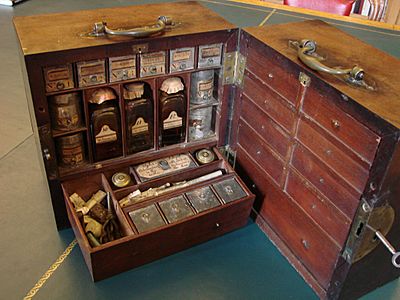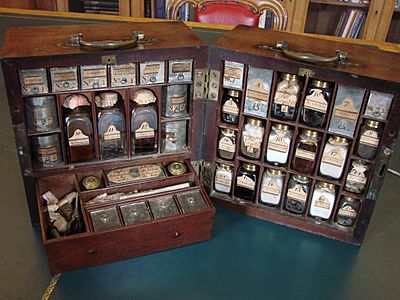Stuart Threipland facts for kids
Stuart Threipland (born May 18, 1716 – died 1805) was a Scottish doctor. He was the son of Sir David Threipland, who was the second Baronet of Fingask. Like his father, Stuart was a strong supporter of the Jacobite cause. The Jacobites wanted to bring the Stuart family back to the throne of Great Britain.
Stuart earned his medical degree from the University of Edinburgh in 1742. Two years later, he became a member of the Royal College of Physicians of Edinburgh (RCPE). In 1745, he joined Prince Charles Edward Stuart, also known as Bonnie Prince Charlie, during the Jacobite rising of 1745. Stuart Threipland became the prince's main doctor and stayed with the army throughout their battles.
After the Jacobites lost the Battle of Culloden in April 1746, Stuart had to leave Scotland and live in France. However, he was allowed to return home in 1747 thanks to a special law called the Indemnity Act 1747. When his father died in 1746, Stuart became the third Baronet of Fingask. But he couldn't use the title officially because his father had lost it for supporting the Jacobites. Stuart worked as a doctor in Edinburgh and was chosen to be the president of the RCPE in 1766. In 1783, he was able to buy back most of his family's lands that had been taken away from his father in 1715.
Contents
Early Life and Education
Stuart Threipland was born in Fingask Castle in Scotland. His father was Sir David Threipland, the second Baronet of Fingask. At the time Stuart was born, the castle was held by government troops. His father was in hiding nearby because he had supported an earlier Jacobite uprising in 1715. Because of this, the family's lands were taken, and his father lost his noble title.
Stuart studied medicine at the University of Edinburgh. In 1737, he helped start the Medical Society of Edinburgh, which later became the Royal Medical Society. He became a Doctor of Medicine in 1742. In 1744, he joined the Royal College of Physicians of Edinburgh and began working as a doctor in the city.
Serving in the 1745 Jacobite Rising
The Threipland family was very loyal to the Jacobite cause. Stuart's first name, spelled "Stuart," showed their support for the Stuart royal family. When Prince Charles Edward Stuart started his rebellion on August 19, 1745, Stuart and his brother David joined the prince's army. Sadly, David Threipland died from a gunshot wound at the Battle of Prestonpans in September 1745.
Stuart Threipland stayed with Prince Charles throughout the entire campaign. He became the prince's main doctor. He was with the Jacobite army as they marched south to Derby and then retreated back north into Scotland. He was also present at the final, crushing defeat at the Battle of Culloden.
After the defeat, Stuart went into hiding with the prince in the Scottish Highlands. Once, they hid in a cave where Stuart cared for another Jacobite doctor, Archibald Cameron of Lochiel. Cameron was later captured and executed for his role in the uprising. Stuart managed to escape by pretending to be a Presbyterian minister. He reached Edinburgh, then changed his disguise to that of a printer's apprentice. From there, he traveled to England and then escaped to France, where he met Prince Charles Edward again in Paris.
Later Life and Achievements
Stuart Threipland was able to return to Scotland in 1747 or 1748. This was possible because of a special law called the Act of Indemnity of 1747. He started working as a doctor in Edinburgh again. On December 4, 1766, he was elected president of the Royal College of Physicians of Edinburgh.
Even though his father died in 1746, Stuart couldn't officially use the title of the third Baronet of Fingask during his lifetime. He lived in different places in Edinburgh, including Fountain Close and Chessel's Court. In his later years, he spent summers at his home in Moredun, south of Edinburgh, and winters in an apartment in Horse Wynd. Later, he stayed at Bishop's Land on the Royal Mile. His medical practice was very successful. This success allowed him to buy back most of the family's lands in Fingask and Kinnaird in 1783. These lands had been taken from his father in 1715.
Stuart Threipland died in Edinburgh in 1805.
Family Life
Stuart Threipland married his first wife, Janet Sinclair, in 1753. After she passed away, he married Janet Budge-Murray in 1761. Stuart and Janet had six children. When Stuart Threipland died in 1805, his eldest son, Patrick, inherited the baronetcy. The title was officially given back to the family in 1826 by an Act of Parliament.
Threipland's Medicine Chest
Stuart Threipland owned a special medicine chest. It is believed that Prince Charles Edward Stuart himself gave this chest to him. We know who owned the chest after Threipland. He gave it to a surgeon named Alexander Wood. Wood's son, Dr. George Wood, then gave it to a Dr. John Smith. Finally, Dr. Smith gave the chest to the Royal College of Physicians of Edinburgh, where it is kept today.
The chest is 10 inches square. Inside, it holds 147 different medical preparations, mostly in glass bottles. These include things like "gums, ointments, powders, balsams, and pills." When this chest was used, medicine was often based on the Theory of Humours. This idea involved using medicines to make people vomit, have bowel movements, or use enemas. Many of the items in the chest were meant to cause these effects.
Most of the medicines were made from plants. However, the chest also shows that doctors were starting to use more chemical-based drugs in the mid-1700s. It contains things like "borax, potassium acid tartarate, dilute sulphuric acid, calamine, zinc oxide, and lead acetate." Besides the medicines, the chest also had special spaces for tools like a mortar and pestle (for grinding), scales with weights, scissors, forceps, a spatula, needles for stitching wounds, paper, and pens.







